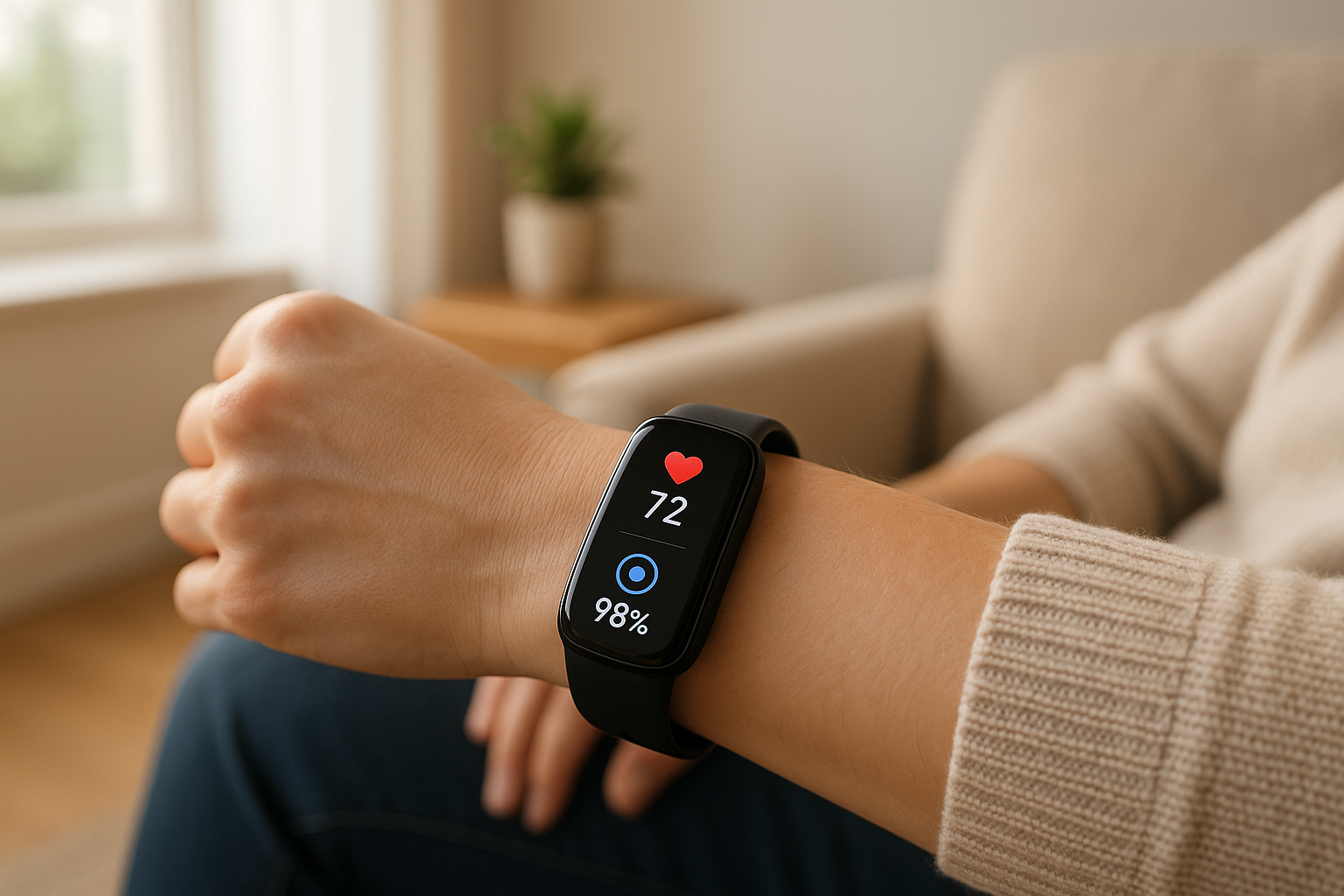Fitness trackers can help you monitor key health metrics like oxygen saturation (SpO2), heart rate, respiratory rate, and sleep patterns - essential for managing COPD symptoms and preventing flare-ups. Here's a quick breakdown of what to look for:
- SpO2 Monitoring: Tracks blood oxygen levels to detect drops during sleep or activity.
- Heart Rate Monitoring: Helps identify early warning signs of exacerbations.
- Activity Tracking: Encourages movement to support lung and cardiovascular health.
- Sleep Tracking: Monitors sleep quality and oxygen levels at night.
- Ease of Use: Look for simple interfaces, long battery life, and compatibility with healthcare apps.
Best Fitness Trackers for COPD
- Fitbit Charge 6: Accurate SpO₂ and heart rate tracking, plus ECG alerts.
- Garmin Vivosmart 5: Lightweight, excellent sleep tracking, and energy monitoring.
- Tenovi Smart Watch: Automatic data sharing with doctors, designed for chronic care.
- Fitbit Sense 2: Advanced health metrics like stress and ECG monitoring.
Quick Comparison
| Feature | Fitbit Charge 6 | Garmin Vivosmart 5 | Tenovi Smart Watch | Fitbit Sense 2 |
|---|---|---|---|---|
| SpO₂ Monitoring | Yes | No | No | N/A |
| Heart Rate Accuracy | High | Standard | - | - |
| Step Tracking | Very Accurate | Standard | Accurate | - |
| Sleep Tracking | Good | Excellent | - | Detailed |
| Data Sharing | Manual | Manual | Automatic | Manual |
Key Takeaways
- Choose a tracker based on the metrics that matter most for your COPD management.
- Comfort and ease of use are critical for consistent daily wear.
- Some devices, like the Tenovi Smart Watch, simplify data sharing with healthcare providers.
Fitness trackers offer real-time health insights that can help you stay on top of your condition and collaborate effectively with your medical team. Always consult your doctor to find the best option for your needs.
Fitbit Alta HR AllDay Activity and Sleep Tracker
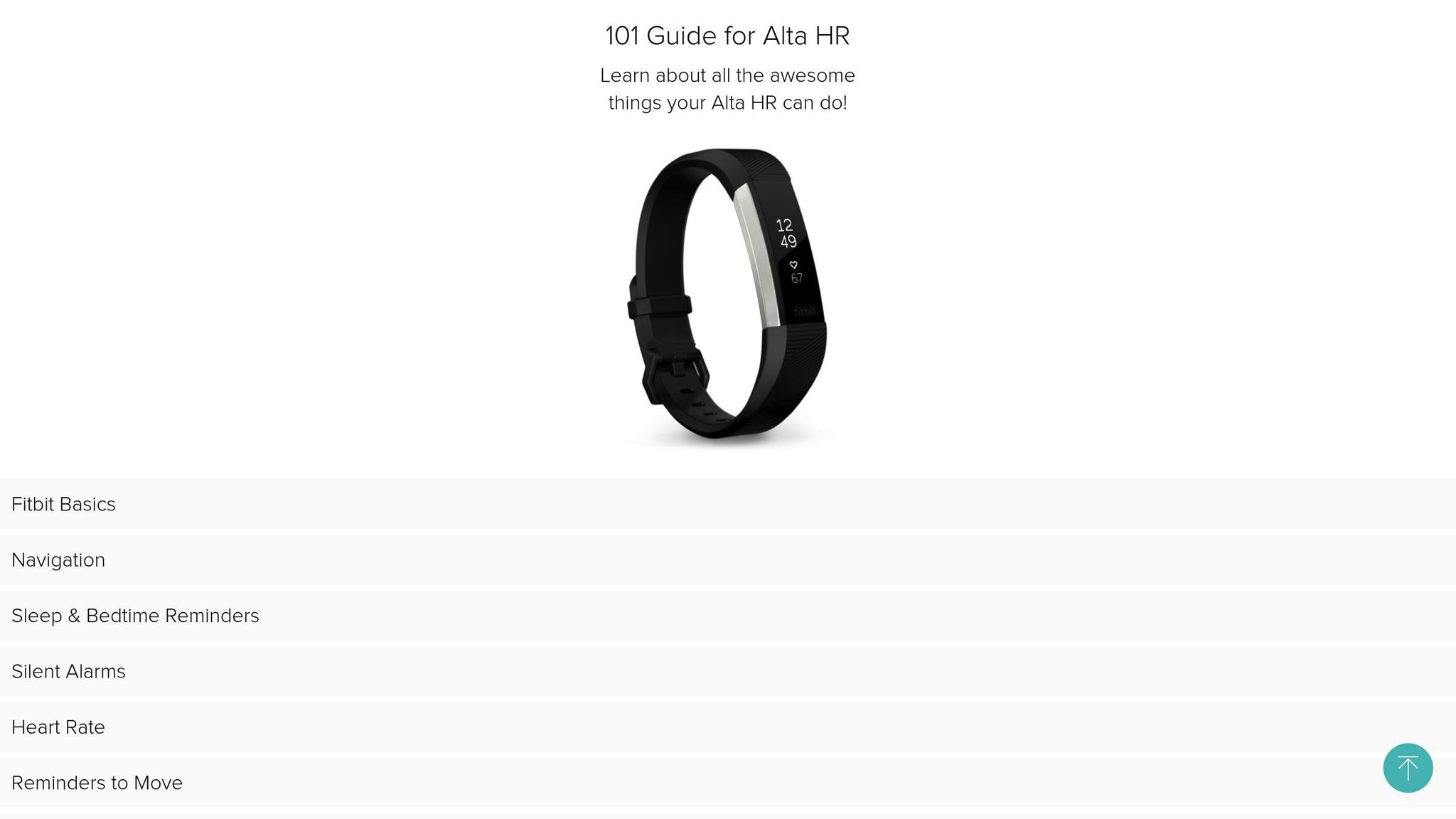
Important Features for COPD Fitness Trackers
When managing COPD, it’s crucial to choose fitness trackers that monitor the right health metrics and are simple to use.
Oxygen Saturation (SpO2) Monitoring
SpO2 monitoring plays a critical role in managing COPD by measuring your blood oxygen levels. It helps identify drops in oxygen during activities, sleep, or flare-ups, allowing for timely action[1].
Unlike traditional finger pulse oximeters used in medical settings, wearable fitness trackers provide round-the-clock SpO2 monitoring. This continuous tracking captures oxygen level trends during daily activities and sleep, offering a more comprehensive picture of your respiratory health. When choosing a device, opt for one that’s clinically validated for accuracy and includes alerts to notify you if your oxygen levels dip below your personalized threshold.
Next, keeping an eye on your heart’s response is equally important.
Heart Rate Monitoring
Monitoring your heart rate helps ensure you stay within safe activity levels and avoid overexertion.
Studies show that a rise in heart rate can signal an impending COPD exacerbation. For example, research found that heart rate increased by an average of 8.1 ± 0.7 beats per minute three days before a flare-up in patients recently discharged after an acute exacerbation[2]. Additionally, reduced heart rate variability (HRV) in COPD patients is linked to poorer overall health outcomes[3]. A consistently elevated resting heart rate or a prolonged increase after mild activity might indicate the need for medical advice.
Step and Activity Tracking
Tracking steps and overall movement encourages COPD patients to maintain physical activity, which supports lung function and overall health. Staying active can help prevent muscle deconditioning and promote better cardiovascular health.
Modern fitness trackers go beyond counting steps - they can differentiate between walking, climbing stairs, and periods of inactivity. Many also include reminders to move when you’ve been sitting too long. When selecting a tracker, focus on devices that offer accurate activity tracking and are easy to use without breaking the bank[6].
Sleep Tracking
Sleep quality has a direct impact on COPD symptoms, and poor sleep can make symptoms worse.
Fitness trackers with sleep tracking features monitor sleep duration, stages, and nighttime oxygen levels. Many COPD patients experience oxygen desaturation during sleep, especially during REM stages when breathing becomes more irregular. By identifying sleep disruptions - like frequent awakenings or restless nights - trackers can provide insights into how COPD is affecting your rest.
Some advanced devices also track nighttime heart rate and movement. Combined with SpO2 monitoring, these features give a more detailed view of your respiratory health during sleep.
Now, let’s talk about usability.
Ease of Use and Compatibility
For a fitness tracker to become a part of your daily routine, it needs to be simple and user-friendly. Many COPD patients face challenges such as limited resources or insufficient clinical support, so having an easy-to-navigate device is essential[4].
Overly complicated features can discourage use, while simplicity encourages long-term engagement[5]. Look for devices with large, easy-to-read displays and intuitive controls, whether through a touchscreen or well-sized buttons.
Compatibility with healthcare apps is another key factor. This allows you to share your data with your medical team for more informed consultations. Even if you’re not tech-savvy, a straightforward design can make continuous monitoring achievable.
Lastly, choose a tracker with a battery life of 5–7 days to avoid frequent recharging interruptions.
Best Fitness Trackers for COPD: Product Reviews
Now that you know what to look for, let’s dive into some fitness trackers that are tailored for managing COPD. Each of these devices brings something different to the table, whether it’s detailed analytics, comfort, or effortless data sharing. Here’s a closer look.
Fitbit Charge 6
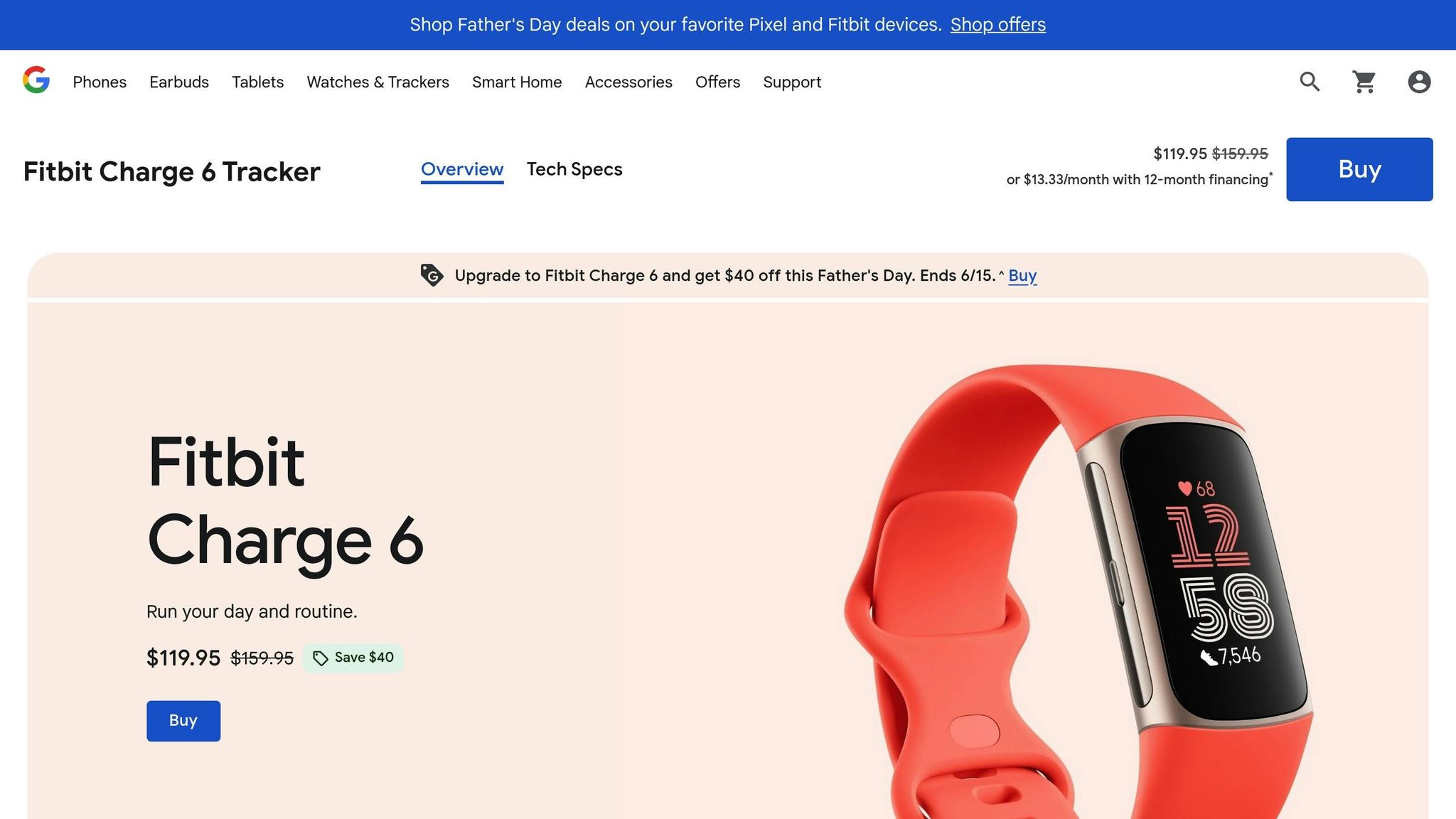
The Fitbit Charge 6 stands out as a versatile and easy-to-use option for COPD management. It features a built-in SpO₂ pulse oximeter, which can help track oxygen levels during sleep and detect any changes overnight[7]. The heart rate monitoring on this model is also 60% more accurate than earlier versions, thanks to an upgraded machine learning algorithm[7]. On top of that, it monitors skin temperature, heart rate variability, and respiration rate, and even provides ECG alerts for irregular heart rhythms[7].
Additional features include step tracking, distance measurement, calorie counting, and built-in GPS for outdoor activities. According to TechGearLab:
"Fitbit is perhaps the most recognizable name in the fitness tracker category, and the Charge 6 is our top pick for being light and simple"[8].
The Charge 6 also scores high on accessibility, with an error rate of less than 1% for step counting and a "Zoom + Magnification" feature that makes notifications easier to read - especially helpful for older adults managing COPD.
Garmin Vivosmart 5
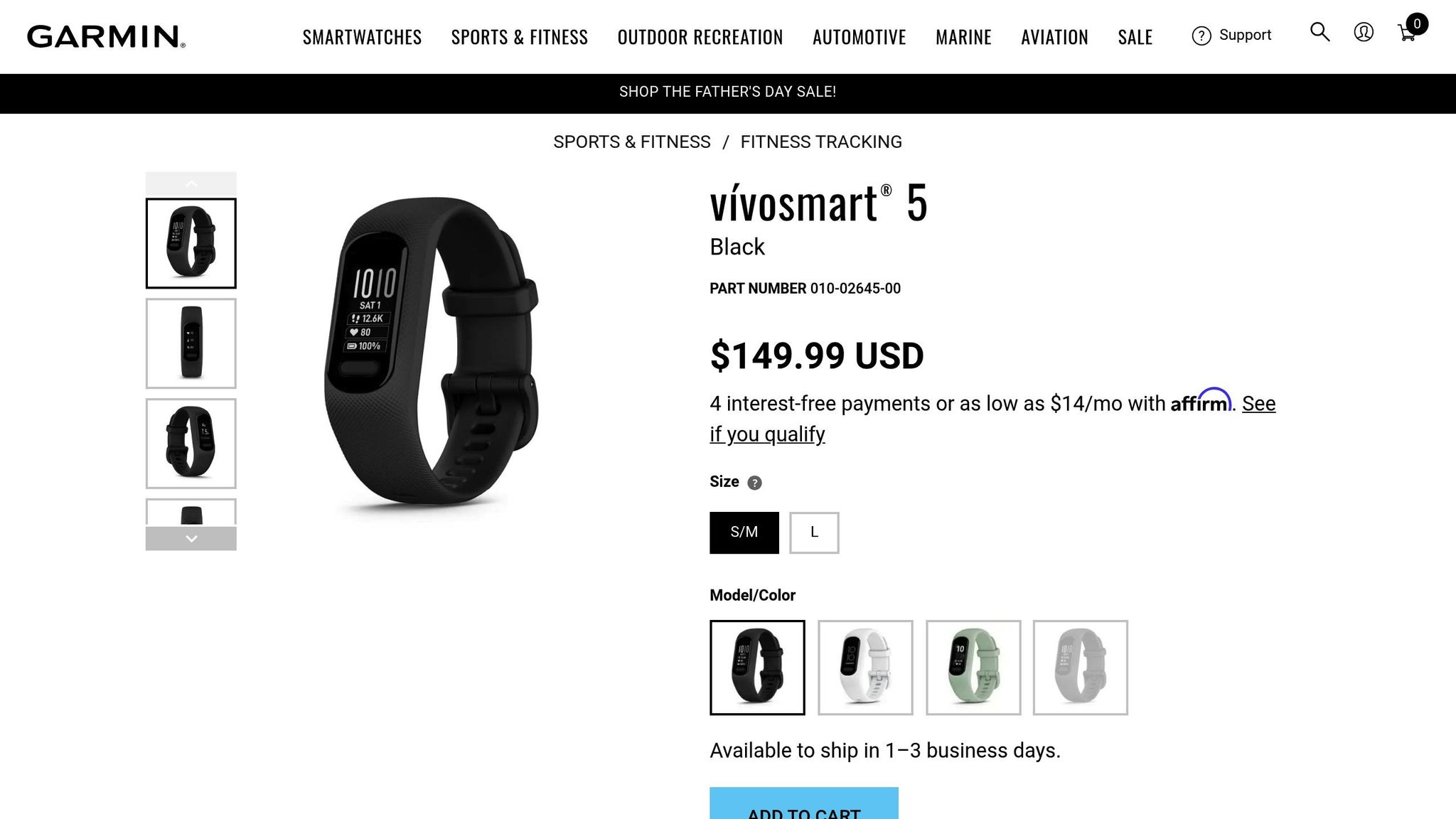
If comfort and sleep tracking top your list of priorities, the Garmin Vivosmart 5 is worth considering. Weighing under 27 g, it’s one of the lightest trackers available[10]. Lexy Savvides, Former Editor at Large for CNET, says:
"It's one of the most comfortable fitness trackers I've tested, and I hardly notice it when sleeping or working out"[11].
This tracker automatically monitors sleep cycles and offers insights into patterns that might impact COPD symptoms. It also tracks daily steps, reminds you to move after long periods of inactivity, and continuously monitors your heart rate. A unique feature is its Body Battery score, which helps you determine the best times for activity or rest based on your energy levels. However, it’s worth noting that the device relies on a connected smartphone for GPS tracking.
Tenovi Smart Watch
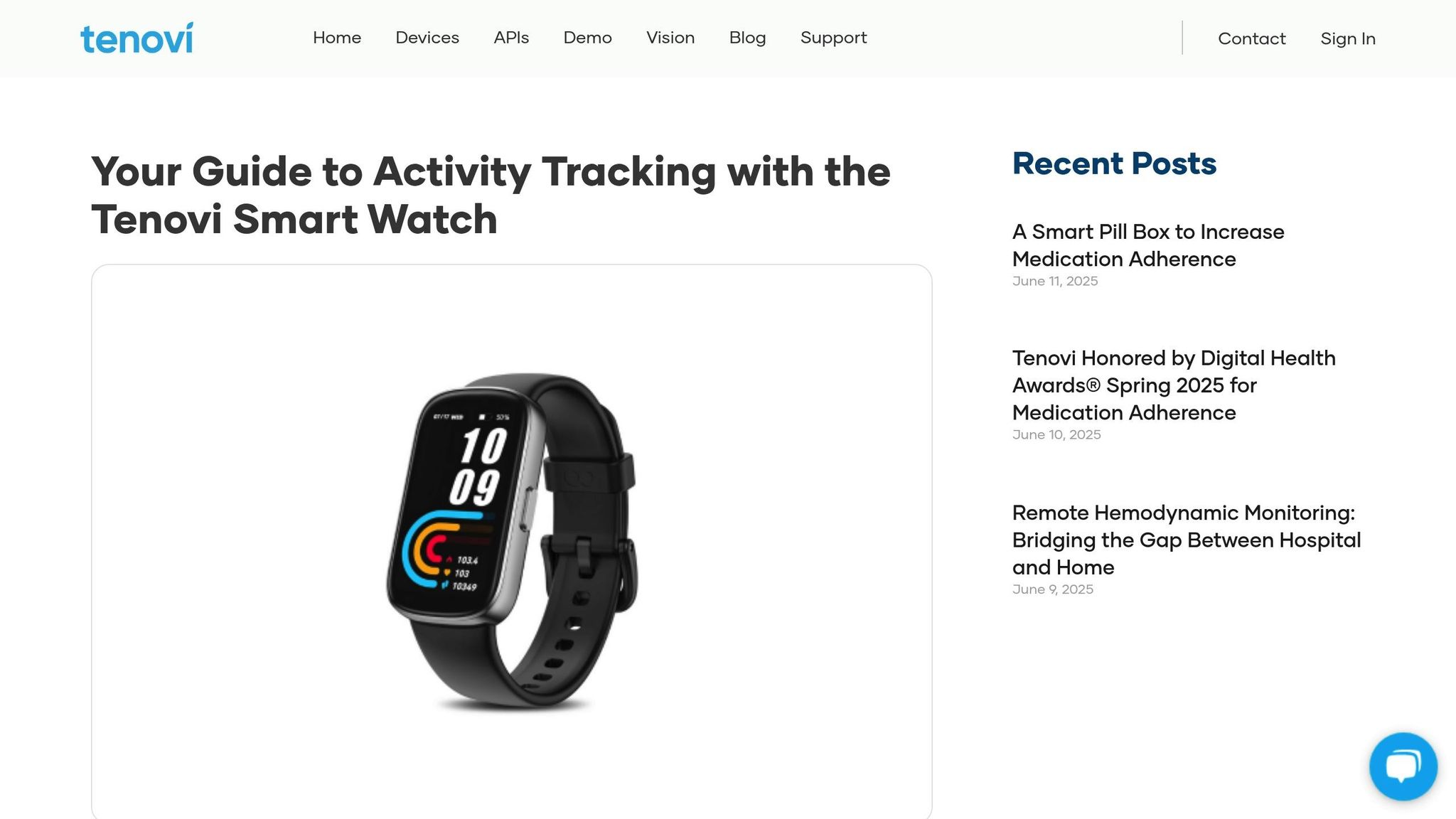
Designed for chronic care, the Tenovi Smart Watch is all about seamless data sharing with healthcare providers. Its standout feature is the automatic daily data transfer via the Tenovi Cellular Gateway, making it easy to share information with doctors[12].
Accuracy is another strong point - its step count is within 5% of Fitbit’s accuracy[12]. Plus, a study revealed that patients using a smartwatch-based intervention like this experienced a 27% lower risk of hospital readmission compared to those receiving standard care[12]. For added peace of mind, Tenovi offers HIPAA-compliant technical support to assist both patients and providers.
Fitbit Sense 2
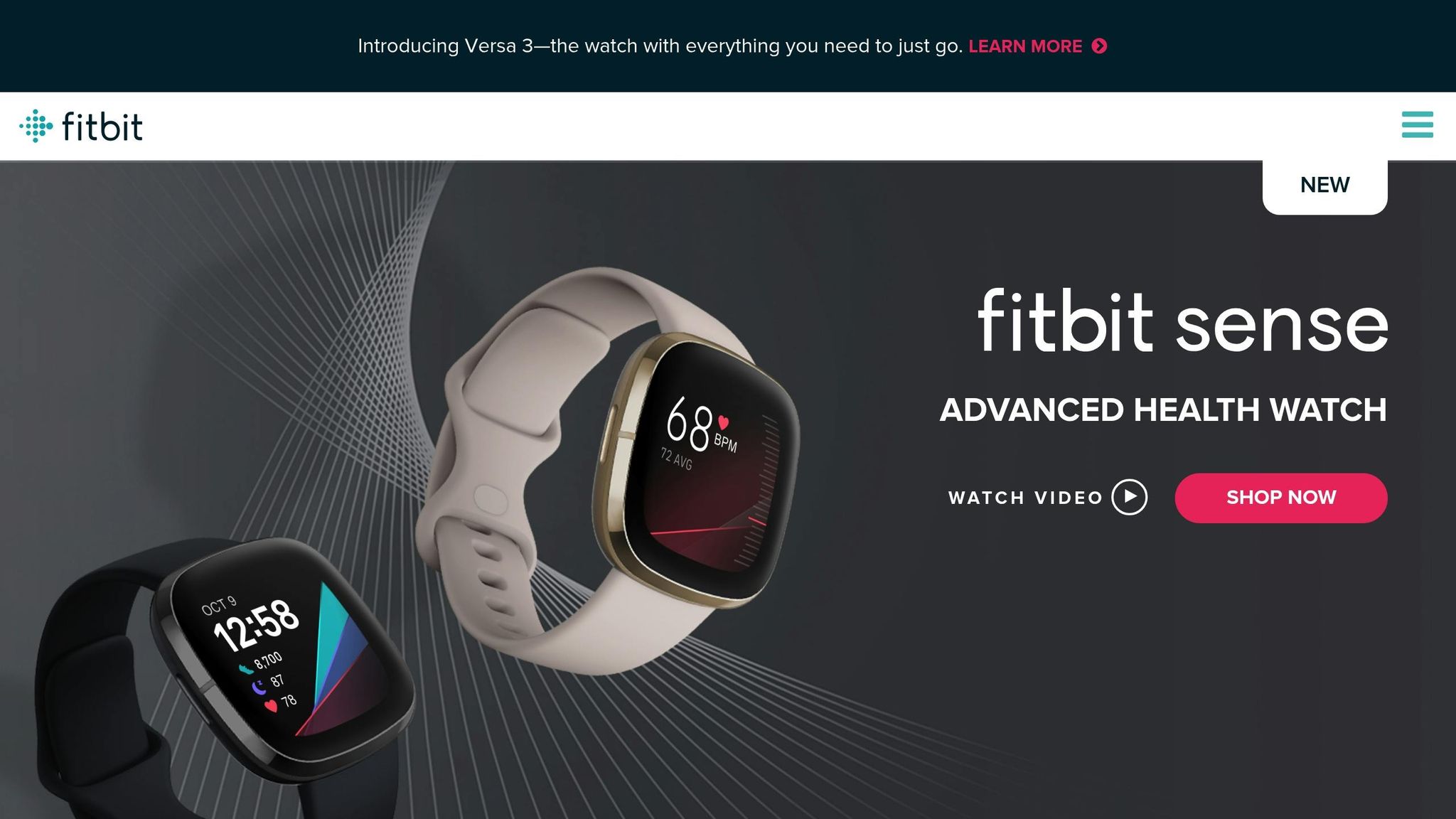
The Fitbit Sense 2 is a great choice for those who want a deeper dive into their health metrics. It includes a continuous electrodermal activity (EDA) sensor to track stress levels throughout the day, which can be crucial since stress often worsens COPD symptoms[9]. It also offers ECG monitoring and detailed sleep analysis, though the Charge 6 may be more comfortable for overnight wear[9].
One of its strengths is app integration, allowing users to sync data with various health apps and share it with healthcare providers. However, the syncing process is manual, unlike the automatic sharing offered by Tenovi[12].
Comparison Table
| Feature | Fitbit Charge 6 | Garmin Vivosmart 5 | Tenovi Smart Watch | Fitbit Sense 2 |
|---|---|---|---|---|
| SpO₂ Monitoring | Yes | No | No | N/A |
| Heart Rate Monitoring | 60% more accurate | Standard | - | - |
| Step Count Accuracy | Error rate <1% | - | Within 5% of Fitbit | - |
| Sleep Tracking | Good | Excellent | - | Detailed (less comfy) |
| Data Sharing with Doctors | Manual | Manual | Automatic daily | Manual |
| Best For | Comprehensive monitoring | Comfort & sleep tracking | Healthcare integration | Advanced health tracking |
Each tracker has unique strengths, so your decision will depend on what matters most to you - whether it’s comfort, detailed health tracking, or easy data sharing with your medical team.
sbb-itb-3e96dba
Buying Considerations for COPD Patients
When choosing a fitness tracker, focus on cost, comfort, and data sharing options. These factors can help you find a device that supports your health without adding unnecessary stress.
Cost and Insurance Coverage
Fitness trackers like the Fitbit Inspire 3 ($99.95, often discounted to around $60)[13] and the Fitbit Charge 5 are affordable options that deliver reliable tracking, long battery life (up to 10 days), and a sleek design. As one review highlights:
"It packs so many features into its slimline, discreet design that it compares favorably to much more expensive wearables, yet comes with a wallet-friendly pricetag" [13].
While insurance coverage for fitness trackers is limited, some medical-grade devices, such as the Omron HeartGuide, may qualify for partial coverage under certain conditions[14]. Check with your insurance provider to see if a prescription makes your device eligible for coverage. Alternatively, consider using HSA/FSA funds to offset costs.
Once you've assessed affordability, shift your focus to how the device feels during daily use.
Comfort and Daily Wear
Comfort plays a key role in ensuring you wear your fitness tracker consistently. A study found that 92% of COPD patients adhered to their monitoring routines when their devices were comfortable to wear[15].
- Weight and size: Lightweight and slim designs are less intrusive and more comfortable for all-day wear.
- Strap material: Silicone straps are hypoallergenic and easy to clean, while fabric straps may offer better breathability but require more care.
- Customization: Some trackers come with interchangeable straps, letting you choose what feels best for you.
Ease of use is just as important. Devices with large, clear displays and simple navigation are ideal, especially if you're not tech-savvy. A user-friendly interface ensures you can focus on your health without struggling with the technology.
After addressing comfort, consider how well the device integrates with your healthcare routine.
Sharing Data with Doctors
A fitness tracker that simplifies data sharing can help you and your healthcare team manage COPD more effectively. Many devices offer options to share health metrics:
- Automatic sharing: Some trackers send data wirelessly to your doctor, keeping them updated without requiring extra effort from you.
- Manual sharing: Other devices allow you to export data through apps, email, or patient portals, giving you control over what to share and when.
To avoid overwhelming your doctor with unnecessary information, look for devices that generate clear data summaries and only send alerts for critical readings. This ensures your healthcare team gets the information they need without being inundated.
As Pierre-Jean "PJ" Cobut, CEO of Spry Health, explains:
"It's not something that stigmatizes you as a sick person. What we've decided to do is basically center the experience around the patients first" [15].
Ultimately, choose a tracker that not only meets your health needs but also empowers you to take control of your well-being without feeling burdened by technology.
COPD Essentials Recommendations
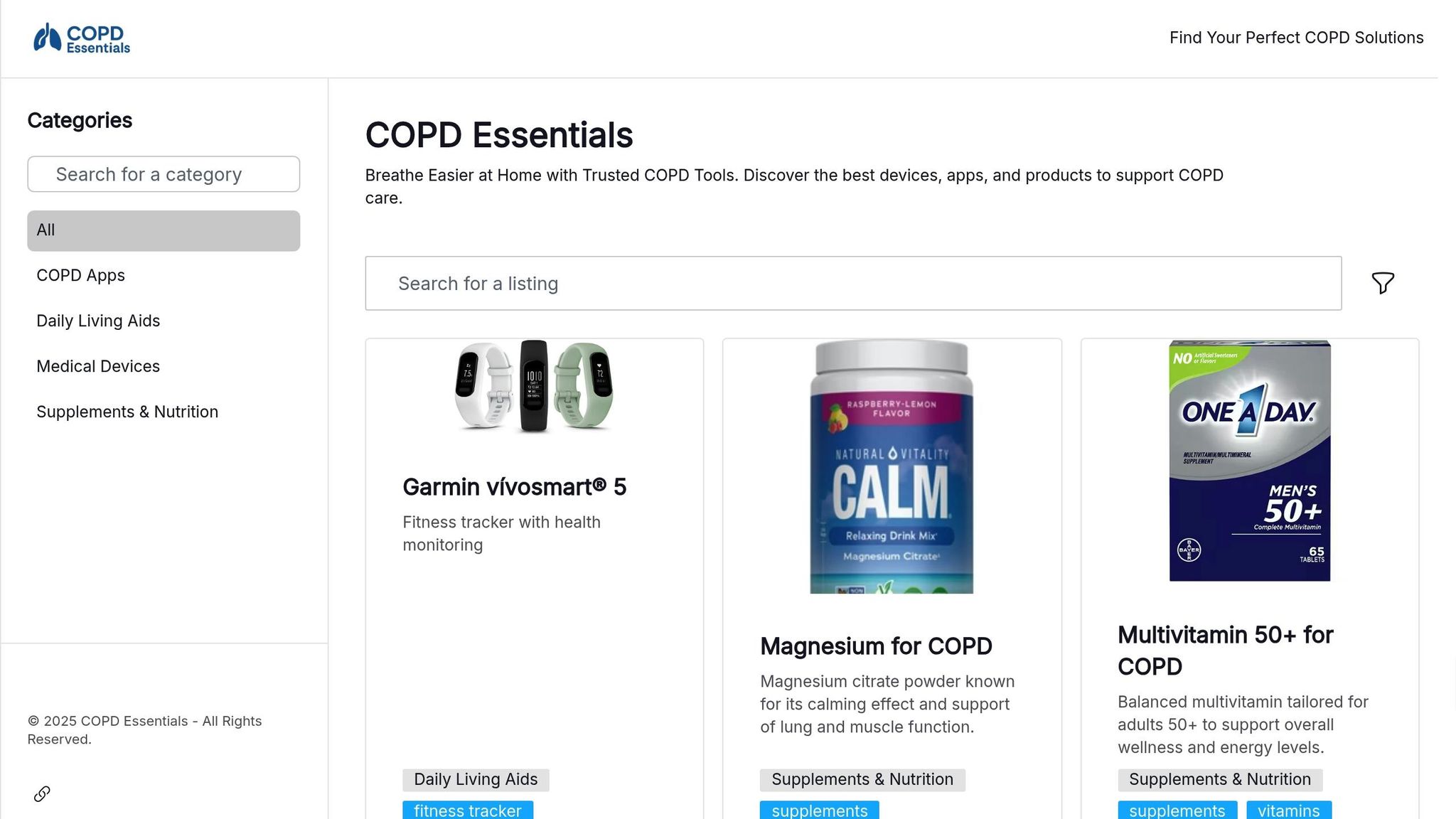
For individuals managing COPD, COPD Essentials highlights the Garmin Vivosmart 5 as a top choice for fitness tracking. With a price tag of around $149.99, this device offers continuous health monitoring and an upgraded display that’s 66% larger than its earlier version [16]. This enhanced screen makes it easier to check vital stats like heart rate, blood oxygen levels, and stress at a glance. Together, these features deliver real-time insights that can help you stay on top of your health.
One of the standout features of the Garmin Vivosmart 5 is its Body Battery, which monitors your energy levels to help prevent overexertion. It also includes advanced sleep tracking, which can detect breathing irregularities during the night - valuable information to share with your healthcare provider. The stress tracking feature, paired with guided breathing exercises, promotes respiratory wellness. Plus, the device’s water-resistant design and long battery life make it reliable for daily use.
Of course, no device is without its drawbacks. The Vivosmart 5 doesn’t have built-in GPS, meaning you’ll need to connect it to your phone for outdoor activity tracking. Its monochrome display might not appeal to everyone, and using the Pulse Ox feature for continuous oxygen monitoring can drain the battery more quickly. These trade-offs are worth considering based on your specific health monitoring needs and lifestyle [16].
For COPD patients, the Garmin Vivosmart 5 strikes a good balance between functionality and ease of use. It’s designed to integrate smoothly into your daily routine, making it simple to track and share data with your healthcare team - an essential part of managing COPD effectively.
Conclusion
Fitness trackers offer a practical way to monitor key health metrics for managing COPD. By keeping tabs on vital signs like heart rate, oxygen saturation, and respiratory rate, these devices can help detect potential issues early, giving you and your healthcare team valuable insights.
When selecting a tracker, focus on what matters most for your needs: reliable SpO2 monitoring, accurate heart rate tracking, and comfort for daily wear. It's also important to choose a device that integrates easily with your healthcare provider's systems. Clinically validated options ensure the data you gather is trustworthy and actionable.
To get started, talk to your doctor about the features that align with your COPD management plan. Set a budget that works for you - fitness trackers range from $24.99 to $199.99 [17] - and make sure the device you choose fits seamlessly into your daily life.
Having real-time health insights isn’t just convenient - it can make a significant difference in managing your condition. The right tracker can serve as a reliable companion, helping you stay active, track symptoms, and collaborate more effectively with your healthcare team.
FAQs
Fitness trackers can play a helpful role in managing COPD by keeping tabs on important health metrics like oxygen saturation (SpO2), heart rate, and respiratory rate. Monitoring these in real-time can alert users to early signs of worsening symptoms, enabling faster action and possibly reducing the need for hospital visits.
These devices also support tracking physical activity, a key factor in maintaining lung function and overall well-being. By offering feedback on daily movement and progress, fitness trackers motivate users to stay active while staying within safe limits. They also encourage individuals to take charge of their health, contributing to better overall wellness and quality of life.
When selecting a fitness tracker to help manage COPD, focus on devices equipped with reliable SpO2 (oxygen saturation) and heart rate monitoring. These features play a key role in monitoring respiratory health and catching potential issues early. While advanced sensors in fitness trackers can offer consistent SpO2 readings, remember that they might not match the accuracy of medical-grade equipment.
Heart rate monitoring is just as crucial. It can highlight unusual fluctuations that may signal cardiovascular strain. Look for trackers that provide real-time alerts for irregular readings, as these can prompt quicker intervention. Also, think about factors like user-friendliness, compatibility with other medical tools, and cost to ensure the tracker aligns with your needs and budget.
Fitness trackers can be a helpful addition to managing COPD, offering the ability to monitor key health metrics like oxygen saturation (SpO2), heart rate, and daily activity levels. They let you keep an eye on your health and may even help you notice early signs of potential problems.
That said, these devices are no substitute for regular visits to your doctor. Healthcare professionals provide detailed evaluations, adjust treatments, and address more complex health concerns - things fitness trackers simply can't do. While trackers can keep you informed and engaged in your health, they should always be used alongside, not instead of, professional medical care.

